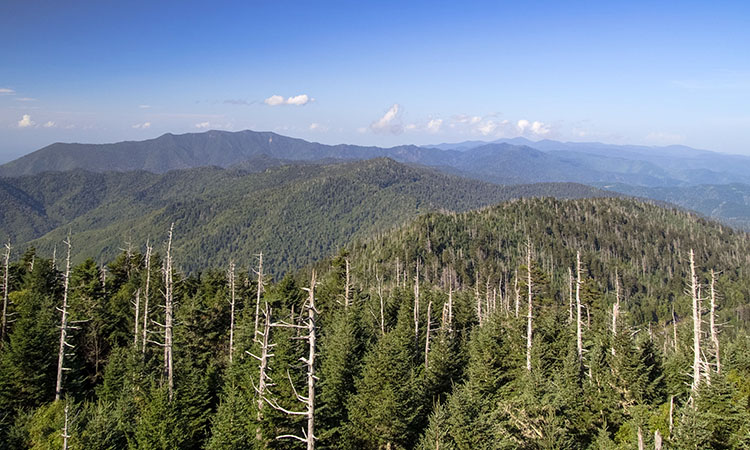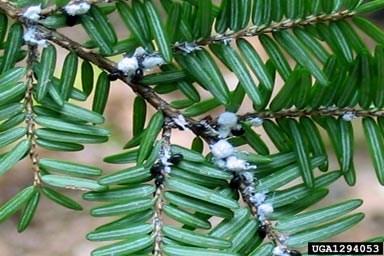Last Updated on June 9, 2023

The mountain vistas of Western North Carolina attract nature lovers from far and wide. But as you look out across the rolling peaks and shady valleys, you may notice an interruption in your view of the Blue Ridge.
Why are all the hemlocks dying?
Those blanched spines were once thriving hemlock trees, some hundreds of years old. Over the past few decades, an infestation has literally drained the life from the trees, leaving only dead trunks with the remains of once-hearty limbs. And while the cause for their demise is well known, the path forward to save the hemlocks has only just begun.
Do you have questions about the dead and dying trees you’ve seen around the region? We answer where the infestation came from and what’s being done to protect the remaining trees. But first, we must understand the hemlocks themselves.
What is a hemlock and where are they?
Eastern hemlock trees (Tsuga canadensis) are often called the “redwoods of the east.” These massive conifers are also among the tallest and most common trees in the Great Smoky Mountains. More than 800 acres of old-growth hemlocks live in Great Smoky Mountains National Park, many measuring over 500 years in age and 150 feet in height—taller than Downtown Asheville’s Jackson Building! An additional 90,000 acres of parkland are covered by young hemlock forests.
Why are hemlocks important?
Because of both their size and long lifespan, hemlocks serve as a keystone species in our mountains. The deep shade healthy trees provide creates distinct microclimates on land and in streams. According to the North Carolina Forest Service:
Brook and brown trout thrive in watersheds with hemlock forests and the hemlock canopy serves as an irreplaceable habitat and foraging site for many birds, especially neotropical migratory birds. Hemlocks are browsed by and provide bedding shelter to deer in the winter, they serve as cavity trees to bears, and they are associated with more than 100 other vertebrates and countless invertebrates. Hemlock ecosystems are truly a unique aspect to our forests that, once gone, will have irreversible cascading effects.
It’s no wonder than certain pagan religions regard hemlocks as a symbol of protection and healing. But what happens when the trees themselves are in need of healing?
What is eating the hemlocks?
Problems with the hemlocks dying in the Smokies first began in 2002. But the source of the problems has been around much longer. The poppy seed-sized, aphid-like hemlock woolly adelgid (Adelges tsugae) first arrived to the east coast from Japan in the 1950s. All wooly adelgids are females that reproduce parthenogenetically, a natural form of asexual reproduction. Without the need for mates, it’s easy for wooly adelgids to produce two generations in a year, during the spring and fall.
After rapidly colonizing parts of New England and the Mid-Atlantic States, the non-native insect traveled south by wind, by birds, and on infested horticultural material. They began to make their way south, feasting on eastern hemlocks, as well as the rare Carolina hemlocks (Tsuga caroliniana) they found in this new habitat.

How can you tell if a tree is infected?
The hemlock woolly adelgid (HWA) protects its egg sacks with a white, wooly coating. These sacks are parked at the base of a tree’s needles, and hatched adelgids feast on the sap running between the branches and the needles. With this nutrient flow disrupted, the needles die, eventually starving the tree. The “cotton balls” of the HWA are most visible on the underside of branches from fall through spring.
Both young and mature trees can suffer from an HWA infestation. And indeed, as many as 80% of infested hemlocks on the Blue Ridge Parkway and in Shenandoah National Park (first infected in the 1980s) have died due to infestation. Damaged trees transform from vibrant deep green to greenish gray in color and have thinning crowns. Dead hemlocks are called “gray ghosts” as a reminder of their once dominant status.
What is being done to protect hemlocks?
Headquartered in Asheville, the Hemlock Restoration Initiative (HRI) is a program sponsored by the NC Department of Agriculture & Consumer Services and the U.S. Forest Service. The HRI is working with a variety of partners to restore hemlocks and sustain their long-term health throughout North Carolina. The goal of the HRI and its partners is to ensure that both eastern and Carolina hemlocks can withstand attacks by the invasive HWA and survive to maturity on public and private lands.
So far, land managers have relied chiefly on chemical treatments for infected hemlocks. Systemic pesticides (imidacloprid) are injected into affected trees, either by soil drenching or directly into the trunk. While this does provide dramatic results, treatments have only proven to be effective for up to three years. Permanent cures like forest restoration techniques and hybridization to breed better resistance are still on the horizon.
Another promising treatment involves the release of predator insects. A beetle species (Laricobious nigrinus) from the Pacific Northwest was released as early as 2006 as a form of biocontrol. It takes time for populations of these beetles to become numerous enough to control HWA infestations, but preliminary monitoring results are encouraging.
What can I do to protect hemlocks?
As we’ve seen, there are many partners involved in the fight to combat HWAs. Learn more about these efforts and what you can do to help from the Hemlock Restoration Initiative. Their next forest restoration alliance open house is scheduled for September 5, 2019 in Waynesville.



